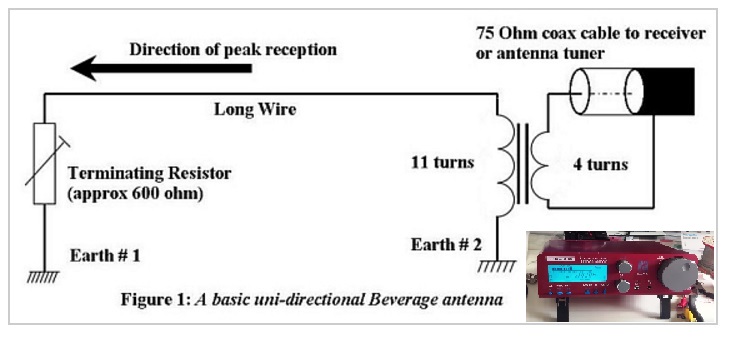Hi there, I have finally deployed the Medium Wave Circle-design 200 metre Beverage antenna (schematic diagram above) at the woods I use in Oxford, UK. It was terminated at the ‘front end’ with a 650 Ohm resistor into a 1 metre-long, permanent copper earthing rod that I had previously driven into the ground, away from the route taken by the general public. The actual wire was orientated in a generally westerly direction, and thus nulling signals propagating from the east. At the receiver end, I utillised my self-built transformer, wound for a 50 Ohm input impedance (14 turns on the primary), thus making the entire set-up suitable for the Elad FDM DUO. It was quite a pain to set up, taking over an hour to deploy the wire and connect both earthing rods and the transformer! However, intial results are very promising and here I am very pleased to share 3 reception videos with you:
- An unprecidented signal from Alcaravan Radio in Colombia on 5910 kHz
- A similarly uprecidented signal from HCJB Quito, Ecuador, on 6050 kHz, wonderful SNR
- The clearest reception of Radio Chaski, Peru I have heard to-date, on 5980 kHz
The reception from Colombia and Ecuador was unprecidented and both of these tropical stations sound like local AM signals, aided of course by the Bose SoundLink Mini 2 (the Elad’s stand-alone audio is puny to say the least). The signal from Peru is weak, as would be expected, however, the low-gain/ high SNR performance of this antenna results in audio clarity that is better than I have ever heard previously from this rather exotic station. Further to these recordings, I managed to make two recordings of the entire MW band using the FDM DUO via the FDM-SW2 software and I’m hoping an analysis of the data will uncover some nice MW DX. Thus, all-in-all, a very good result with the 200 metre Beverage – more reception videos using this antenna to follow soon on my youtube channel Oxford Shortwave Log. Thanks for watching/ listening and I wish you all good DX.
Embedded reception videos with text links follow below:
Clint Gouveia is the author of this post and a regular contributor to the SWLing Post. Clint actively publishes videos of his shortwave radio excursions on his YouTube channel: Oxford Shortwave Log. Clint is based in Oxfordshire, England.


I drive for a living and one night years ago I was parked on a side street outside of our office. I forgot what frequency I had the AM radio on in the car but I heard call letters that were unfamiliar to me. Living in Oregon I can get a lot of stations from CA, NV, BC, UT, etc. so I didn’t think much of it but took the letters down out of curiosity. I moved the car up about a foot to see if I could get a better signal but when I did I lost the signal. Backed up a foot and there it was.
I went home and looked up the call letters and darned if they were not in Chicago! I should had know something was up since the call letters started with a ‘W’ but didn’t get the significance at the time. The next night I repeated the experiment and sure enough the only place I could get that faint signal anywhere was in that one sweet spot. Real Twilight Zone stuff!
Great work on the beverage antenna. Can you get any US West Coast stations?
Thanks for your comments! I’ve not heard US West Coast Stations, although I know it’s possible. I think they do sometimes appear in Europe later in the morning and particularly on the X-band. 73!
A good reminder that a good receiving antenna is more than a long chunk of wire. Two months ago I happened upon 2,1600 meters (!) of abandoned railroad telegraph wire suspended in a straight line on 10-12 foot posts. The wire was at least 2mm thick but was galvanized steel (high resistance). When I found the line it was steel covered with 99% rust. The galvanizing zinc was mostly gone. Add to this the fact that both ends of this “found” antenna were touching ground. I didn’t want to cut the wire to correct the ground to beverage antenna specs, although I tested the wire to assure that no voltage was present on the line. The railroad that owns this line is still in business although they run only 1-2 trains per day. I didn’t want to take the chance that they were still using this line for some nasty signaling circuits. Chances are this telegraphy line hasn’t been used for 40 years. Still, I didn’t want the engineer to see me on the RR right-of-way holding a portable radio and a connector wire to telegraph lines when he called the local cops to visit me.
Incidentally, I used sandpaper to clean all oxidation from the telegraph wire before connecting a claw clip lead to my portable radio antenna jack. The 2.1000m telegraph line antenna wasn’t any better than the 100′ copper long wire antenna I use at home. Maybe next time, but I don’t want to trespass on RR property any more.
Thanks for a very interesting account of your experience with an ultra-long antenna. As far as Beverage antennas are concerned there’s the principle of MEL – Maximum Effective Length which might come into play with your abandoned telegraph wire. I generated a powerpoint presentation (on my youtube channel) to cover some of the maths, which appear simple, but in reality it can get quite complex! 73!
Thanks for posting the bev antenna drawing, that inspires me to go beyond my longwire!
My pleasure Kire. 73!